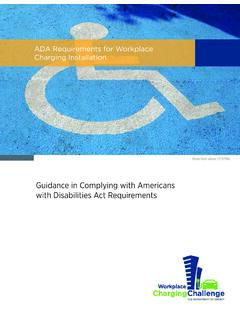Transcription of Battery Charging Terminology - Amtex
1 There are three main categories of rechargeable batteries batteriesUsed to supply primary power to start engines on cars, boats and other vehicles. They provide ashort burst of high current to get the engine batteriesDesigned to be permanently connected in parallel with a critical load and a rectifier/charger system,where the rectifier/charger forms the primary source of power for the load and the Battery providesthe secondary source in the event of a primary source batteriesDesigned to power portable equipment such as consumer products and tools such as drills, mobilephones, laptop computers and so latter two categories can be further broken down by the chemistries used in the construction ofthe (NiCd) (vented & semi-sealed)- mature but have moderate energydensity.
2 Nickel-cadmium batteries have generally been used where long life, highdischarge rate and extended temperature range is important. Nickel-cadmium batteriescontain toxic metals and are generally being phased (NiMH)- have a higher energy density compared to nickel-cadmium at the expense of reduced cycle life. Contain no toxic (Li-ion)- fastest growing Battery technology offering high energy density andlow weight. Requires protection circuits to limit voltage and current for safety (vented & valve-regulated) batteriesMost economical for larger power applications where weight is of little of the main differences between the above Battery types is the initial purchase cost of thebattery.
3 However, when selecting a Battery , the initial cost can give a very misleading impression ofthe total cost to the user during the system s selection of a Battery based on cost alone can have a major impact on the life cycle cost of thesystem being supported due to such factors as installation, replacement, maintenance, testing anddowntime many instances, the selection of the most suitable Battery for a particular application can be a verycomplex calculation that can only be performed by the end user as a number of the factors relatingto life cycle cost are outside the control of the Battery supplier maintenance for example. However,some basic logic can be applied by the supplier assuming some data has been provided, includinglocation and access to site, site ambient temperature and the nature of the application.
4 It would belogical to select a nickel-cadmium Battery for a remote unmanned site in the Middle East with anambient temperature of 45 C during the day and 5 C at night, where the load being supported isBattery Charging Terminology Battery Charging Topology15vital to the production of oil. However, if the equipment was to be housed within an air-conditionedroom in a well-maintained oil production facility it would be reasonable to utilize valve-regulated leadacid Associated with Standby BatteriesCellA cell comprises a number of positive and negative charged plates immersed inan electrolyte that produces an electrical charge by means of an electrochemicalreaction. Lead acid cells generally produce an electrical potential of 2V whileNickel-cadmium cells generally produce an electrical potential of Battery is a number of cells connected Battery string or bank comprises a number of cells/batteries connected inseries to produce a Battery or Battery string with the required usablevoltage/potential 6V, 12V, 24V, 48V, Ah or Ampere/hour capacity is the current a Battery can provide over aspecified period of time.
5 100Ah @ C10 rate to EOD of Thismeans the Battery can provide 10 Amps for 10 hours to an end of dischargevoltage of per Battery manufacturers will use different Cxx rates depending on themarket or application at which their batteries are targeted. typical rates used areC3, C5, C8, C10 and C20. Because of this it is important, when comparingbatteries from different manufacturers having the same Ah rate, to confirm onwhat Cxx rate this figure is :An application requires a 100Ah Battery at the C3 rate, based on a load profileof 33 Amps for 3 hours to an end discharge of per cell. However, whentwo Battery manufacturers are asked to tender for this project, the only datathey are given is that a 100Ah Battery is can be seen above, both manufacturers can offer a 100Ah Battery based onthe limited specification provided, but only the Battery from manufacturer A iscapable of supporting the intended load A - 105Ah @ C3 Rate to ( 3 hour discharge rate)Manufacturer B - 102Ah @ C10 Rate to ( 10 hour discharge rate)Standby Time (Hrs)12358101220 Manufacturer A (Cxx rate) B (Cxx rate)
6 VoltageEnd of discharge voltage is the level to which the Battery string voltage or cellvoltage is allowed to fall to before affecting the load or 21V on anominal 24V of life factorThis is a factor included within the Battery sizing calculation to ensure the batteryis able to support the full load at the end of the Battery design life, calculated bymultiplying Ah by the energy stored within a Battery cell is the result of an electrochemicalderate factor reaction, any change in the electrolyte temperature has an effect on theefficiency or rate of reaction. an increase in temperature increases theefficiency/rate whereas a decrease in temperature reduces the efficiency/rate ofreaction.
7 As a result of this, all Battery manufacturers discharge data will bespecified at a recommended temperature (typically 20-25 C) with temperaturecorrections provided for operation above and below these temperature correction factors for Valve Regulated Lead Acid (VRLA) batteriesTypical reduction in design life against temperatureHigh temperatures will reduce the service life of VRLA batteries dramatically andcan, in extreme cases, cause thermal runaway, resulting in high oxygen orhydrogen gas production and Battery swelling. Batteries will not recover fromthis condition and must be ratedurationTemperature Correction Factors to be applied to 20 C data at:0 C5 C10 C15 C20 C25 C30 C35 C40 C5 minutes to59 hourto 24 C25 C30 C35 C40 C45 C50 C% ExpectedFloat Life100%100%80%60%40%20%10%17 TemperatureAs previously detailed, the energy stored within a Battery cell is the result of ancompensationelectrochemical reaction, so any change in the electrolyte temperature has an effecton the rate of reaction provided all other factors (charge voltage and current)
8 Relating to the reaction remain , if we alter these factors to compensate for the effect of temperature, wecan minimize the effect of temperature on Battery life by maintaining the amount ofgas evolved within a VRLA or semi-sealed nickel cadmium Battery to approximatelythe normal operating simplest way of maintaining the rate of reaction within design parameters is toalter the charge voltage at a rate proportional to the change in temperature, the charge voltage with an increase in temperature above 20-25 C andincrease the charge voltage with a decrease in temperature below 20-25 C. Thetypical change in charge voltage is 3 mV / chargeCharge given to a Battery to correct voltage imbalance between individual cells andto restore the Battery to fully charged process of replenishing or replacing the electrical charge in a rechargeable cellor lifeThe number of cycles (charge/discharge) a Battery provides before it is no longerusable.
9 A Battery is considered non-usable if its nominal capacity falls below 60 to80 non-metallic conductor of electricity between the positive and negative electrodesof a Battery . The current is carried by the physical movement of chargeSee Boost chargeTerm generally associated with NiCd batteries. The typical fast charge time isbetween one and three hours. The fast-charger detects the state of charge andswitches to trickle charge when full charge is chargeSimilar to trickle charge. Compensates for the self-discharge of a lead acid Reversible capacity loss in NiCd and NiMH batteries. The modern definition of memory commonly refers to a change in crystalline formation from the desirablesmall size to a large size.
10 Memory is often used to describe any reversible capacityloss on nickel-based voltageThe cell voltage that is accepted as an industrial standard. (Cell voltages of are used for NiCd and NiMH batteries).Quick chargerA charger that charges a Battery in three to six chargerSame Terminology as quick Capacity loss during storage due to the internal leakage between the positive andnegative cell chargeTypically an over-night charge lasting 10 to 16 hours at a charge current ( x Ah capacity in Amps). The Battery does not require instant removalwhen fully A condition whereby an electrochemical cell will overheat and destroy itselfrunawaythrough internal heat generation.





